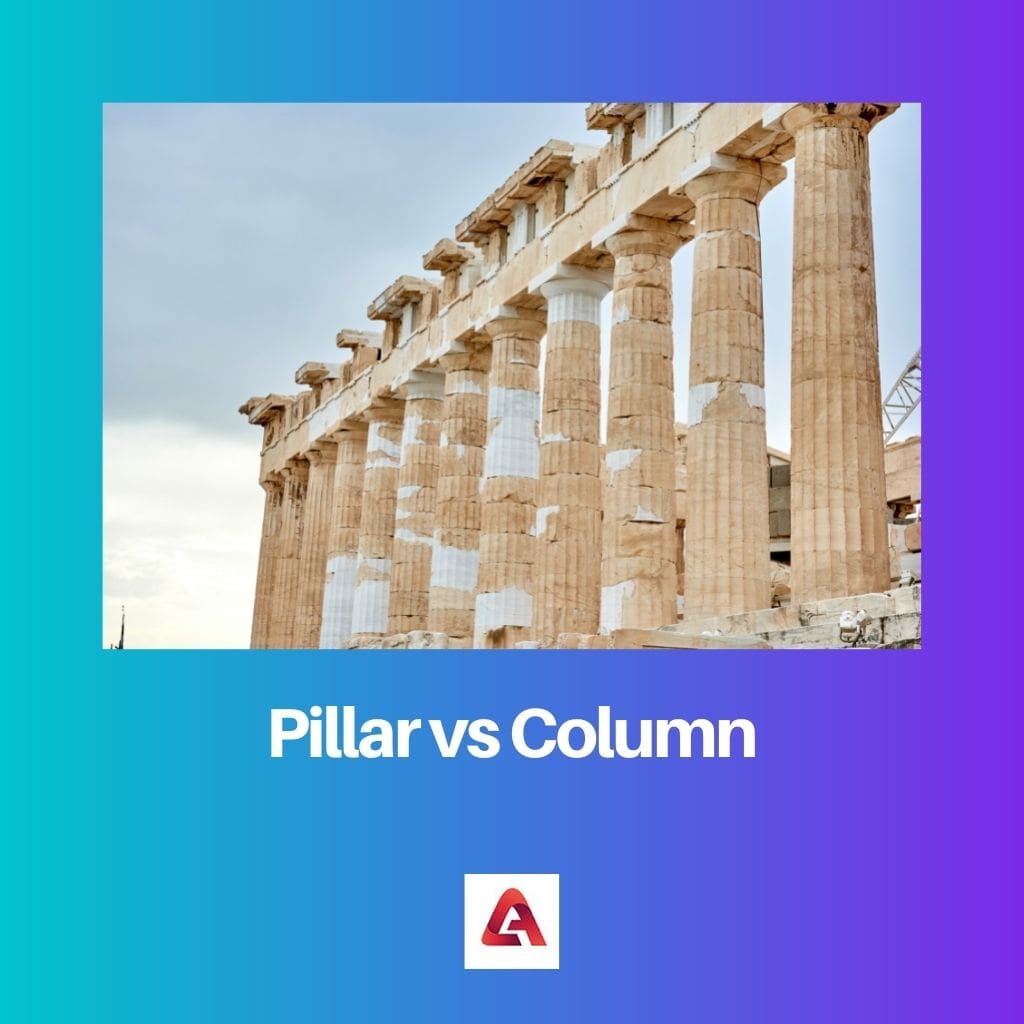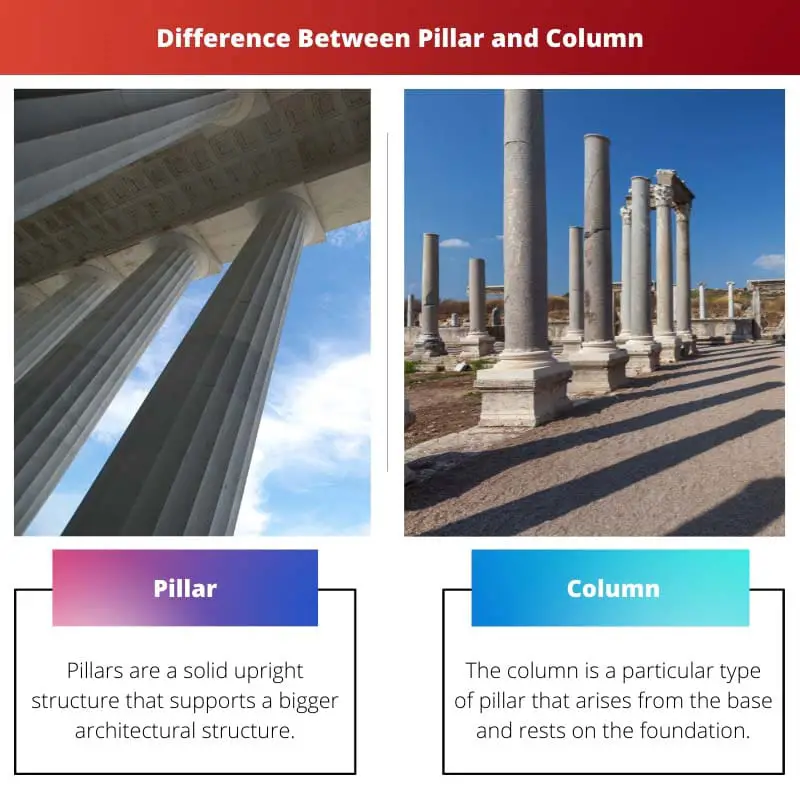Both Pillar and Column are cylindrical structures standing upright to support a structure above terms such as a building or horizontal beam. Although pillars and columns have common architectural factors, they can be used in different contexts.
Key Takeaways
- Pillars are vertical, freestanding architectural elements used to support weight and provide structural stability; columns are similar but may be connected to a larger structure and have a specific style, such as Doric or Ionic.
- Pillars are larger and thicker, with a wider base and a more decorative capital; columns are slimmer and more uniform, with a capital that may feature ornate carvings or details.
- Pillars may be used in various building types and styles, while columns are more commonly associated with classical architecture.
Pillar vs. Column
A pillar is a vertical support that is freestanding and not connected to any other structure and is ornamental and decorative and can be made from various materials such as stone or wood. A column is a structural element that is part of a larger system of supports, such as in a building.

A pillar is a huge solid structure, cylindrical, standing upright to support another larger structure, such as a monument or building. It can be a standalone structure as a decorative piece, but in a wider sense, it is designed to withstand weight like a building roof as a supportive structural element.
The column is a specific type of pillar that has exceptional load-bearing capacity. It can be a vertically aligned cell in a table or chart.
They are used to specify certain featured sections in newspapers or magazines.
Comparison Table
| Parameter of Comparison | Pillar | Column |
|---|---|---|
| Definition | Pillars are a solid upright structure that supports a bigger architectural structure. | The column is a particular type of pillar that arises from the base and rests on the foundation. |
| Feature | A tall pillar is a standing element, constructed out of bricks or stones. | The column is used in architectural or engineering structures, made of masonry or steel. |
| Purpose | It can also be used as decorative elements. | It can be used as a standalone structure. |
| Nomenclature | A pillar can be a column. | The column cannot be a pillar. |
| Uses | A pillar can be used in an architectural context as a structural or decorative element. | The column can be used in different contexts, such as a series of vertically arranged cells in a table or chart or as a featured section in newspapers or magazines. |
What is a Pillar?
An a-Pillar is a tall vertical cylindrical structure of metals, stones, or wood used as an ornament or support for a building or monument. It is approximately shaped like a column or tower.
A pillar commonly functions as a stabilizing or load-bearing. Sometimes a pillar is also used as a standalone decorative element.
A pillar is an important part of anything much bigger, constructed out of masonries such as bricks, concrete, or stones. The pillar was first introduced in Egypt with experiments in enlarging the covered structure.
Their pillar was first used as support for roofing in their millennium b.c.e. As a result, the pillar served not only as an ornament of the building but also as a support for the larger monuments.
In Mesopotamia, these began to be used in the middle of the second millennium b.c.e. By the spelling of the pillar itself; there are two pillars right in the middle of the word that holds the whole word upright.
Therefore, from the word and its spelling, it is crystal clear that a pillar is meant to support a structure.
Sometimes they are called pedestal, support, tower, or shaft. But according to the English usage pillar is suggested as the best-suited word when it comes to its uses.

What is a Column?
The column can be a vertical series of cells in a spreadsheet, table, or chart. It is also designed to carry flexural or axial loads combination.
According to any civil engineering, it is a slender compression member compared to its length under gradually increasing load. Sometimes it is also a decorative pillar, mostly made of stone, having a polygonal or cylindrical shaft with a base.
Some people believe it to be a regular feature or series of articles in a magazine or newspaper, which has identifiable headings. This feature reports on comments on a specific field of interest, such as threats, law, politics, etc.
The column’s history is traced back to the Iron Age Civilization of the Mediterranean. In 1224 BC, columns were famously present in the Great Hypostyle Hall of Karnak, where 134 columns are lined up in sixteen rows with far-reaching heights of 24 meters.
This column witnesses its origin in the fifth dynasty, composed of Lotus stems drawn together into bundles decorated with bands.

Main Differences Between Pillar and Column
- Pillars are solid upright structure that supports a bigger architectural structure. On the other hand, the column is a particular type of pillar that arises from the base and rests on the foundation.
- A tall pillar is a standing element, constructed out of bricks or stones. , the column is used in architectural or engineering structures, made of masonry or steel.
- A pillar can also be used as a decorative element. And the column can be used as a standalone structure.
- A pillar can be a column. But, The column cannot be a pillar.
- A pillar can be used as a structural or decorative element in an architectural context. On the other hand, the column can be used in different contexts, such as a series of vertically aligned cells in a table or chart or as a featured section in newspapers or magazines.

- https://pubs.rsc.org/en/content/articlehtml/2019/an/c8an01937a
- https://pubs.rsc.org/en/content/articlehtml/2019/an/c8an01937a

An enlightening read on the distinctions between pillars and columns. The clear differentiation between the two architectural elements adds depth to one’s understanding of architectural design.
I completely agree. Understanding these architectural features is crucial for appreciating different design styles and historical buildings.
This article is very informative and well-structured. It provides comprehensive insights into the historical background and the specific features of pillars and columns.
As an architecture enthusiast, I found this piece to be thorough and enlightening. The in-depth comparison between pillars and columns offers valuable knowledge for architecture students and professionals.
Indeed, the article’s focus on the historical dimensions of pillars and columns deepens one’s appreciation for architectural innovation and design principles.
The detailed description of pillars and columns, accompanied by historical references, enriches the readers’ understanding of these architectural elements.
The historical context adds depth to the article, making it an engaging and informative piece.
The writer’s emphasis on historical evolution enhances the value of the article, providing a holistic understanding of the architectural elements being discussed.
An interesting read, especially the historical context of pillars and columns. The article effectively conveys the distinctive characteristics of each architectural element.
The historical insights are engaging. The article provides a rich understanding of the evolution and usage of pillars and columns.
The detailed comparison between pillars and columns is intriguing. I appreciate the meticulous explanation of their uses and characteristics.
Agreed, the article does an excellent job in presenting the definitions and purposes of pillars and columns in various contexts.
Although the information is well-organized, the article lacks a critical analysis of the structural implications of pillars and columns.
That’s a valid point. A closer examination of the structural elements and engineering significance would provide a more comprehensive understanding of pillars and columns.
The comparison table is very helpful and makes it easy to grasp the key differences between pillars and columns. However, more illustrations or examples would further enhance the article’s clarity.
I agree, visual aids would be beneficial. Nevertheless, the content is informative and well-presented.
The absence of visual references is indeed a drawback, but the textual information is thorough and precise.
I appreciate the historical background offered in the article. It’s an insightful read for those passionate about the historical development of architectural elements.
The historical insights are indeed compelling. They accentuate the enduring significance of pillars and columns in architectural design.
Absolutely, the historical context is fascinating. It provides a broader understanding of architectural evolution and the diverse applications of pillars and columns.
This article provides a clear and concise explanation of the differences between pillars and columns, highlighting the specific characteristics of each. It’s definitely a must-read for those interested in architecture and engineering.
It provides a thorough comparison that is easy to understand. The historical context is especially interesting!